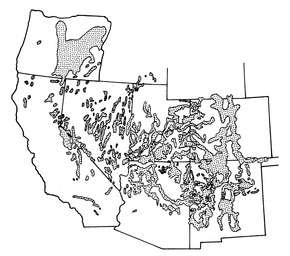Pinyon-juniper woodland
Pinyon-juniper woodland, also spelled Piñon-juniper woodland, is a vegetation type (biome) of Western United States higher elevation deserts, characterized by being an open forest dominated by low, bushy, evergreen junipers (Juniperus osteosperma,[1][2] Juniperus californica,[2][3] Juniperus grandis[3]), pinyon pines (Pinus monophylla,[2][3] Pinus edulis[2]), and their associates which vary from region to region.[1][4][5] The woodland's crown height may vary from less than 10 meters up to 15 meters, depending on the site.[6] It may consist of pure stands of pinyon pine, or pure stands of juniper.[3]
Range

The Pinyon-juniper woodland range spans from New Mexico, to the eastern Sierra Nevada, the Colorado Plateau, the Great Basin, and higher elevations of Mountain ranges of the Mojave Desert. The woodland's range includes the Mogollon Rim in the south, to its northern extent in the Snake River Plain.[7]
Arizona and New Mexico
The Pinyon-juniper woodland is one of the most prevalent types of coniferous woodland in northern Arizona and New Mexico.[8]
Utah and Canyonlands Region
The pinyon-juniper plant community covers a large portion of Utah and the Canyonlands region.[1] singleleaf ash (Fraxinus anomala), and Utah serviceberry (Amelanchier utahensis) are codominants of pinyon pine and Utah juniper in this region.[1] in this region, the community occurs on rocky soils or jointed bedrock.[1]
Mojave Desert
In the Mojave Desert, this vegetation type can be found in areas receiving 12-20 inches of annual precipitation, and between 4,500 and 8,000 feet.[2] Associates include bitterbrush (Purshia glandulosa), Apache plume(Fallugia paradoxa), desert sagebrush (Artemisia tridentata), green ephedra (Ephedra viridis), mountain mahoganies (Cercocarpus spp.), and buckwheats (Eriogonum spp.).[2] In the Mojave, pinyon-juniper woodlands are generally above the Joshua Tree Woodlands vegetation type, and requires more annual precipitation.[2][9]
Sierra Nevada
In the eastern Sierra Nevada, the elevation range is 4,000-5,500 feet in the north, and 5,000 to 8,000 feet in the southern reaches of the range.[3] Pinyon-juniper woodland requires 12-20 inches of annual precipitation, so is generally located above the sagebrush scrub vegetation type, which can survive on an average of 7 inches per year.[3] It is located below the alpine zone.[3] There is often an understory dominated by sagebrush (Artemisia tridentata) and its associates.[3] Co-dominants include Jeffrey Pine (Pinus jeffreyi) and an understory of sagebrush scrub or rabbitbrush scrub (Ericameria spp.).[3]
- Junipers, dominant species:
- Pinyon Pine, dominant species:
- Pinus edulis (Colorado Pinyon or Two-needle Pinyon)
- Pinus monophylla (Single-leaf Pinyon)
See also
- Category:Flora of the Southwestern United States
- Category:Flora of the Great Basin
- Category:Flora of the California desert regions
References
- 1 2 3 4 5 Damian Fagan, Canyon Country Wildflowers, p. 3
- 1 2 3 4 5 6 7 Pam MacKay, Mojave Desert Wildflowers, p19-20
- 1 2 3 4 5 6 7 8 9 Karen Wiese, Sierra Nevada Wildflowers, 2013, p. 18
- ↑ Ronald J. Taylor, Sagebrush Country
- ↑ Laird Blackwell, Great Basin Wildflowers, p5-6
- ↑ "[Pinyon-juniper ecosystem]". Digital-Desert: Mojave Desert. Retrieved 1 February 2016.
- ↑ Cronquist, (1972).
- ↑ Dick-Peddie, (1999) pp. 87.
- ↑ Adrienne Knute, Plants of the East Mojave, p31.
Sources
- Dick-Peddie, William A. (1999). New Mexico Vegetation: Past, Present, and Future. University of New Mexico Press. p. 280. ISBN 0-8263-2164-X.
- Cronquist, Arthur; Arthur H. Holmgren; Noel H. Holmgren; James L. Reveal; James Reveal; Noel Holmgren (1972). Intermountain Flora - Vascular Plants of the Intermountain West, U.S.A. - Geological and Botanical History of the Region, its Plant Geography and a Glossary. Vol. 1. The New York Botanical Garden Press. p. 270. ISBN 0-89327-300-7.

